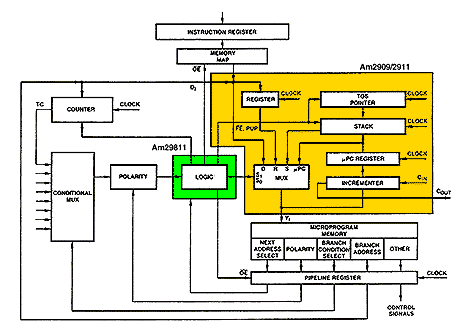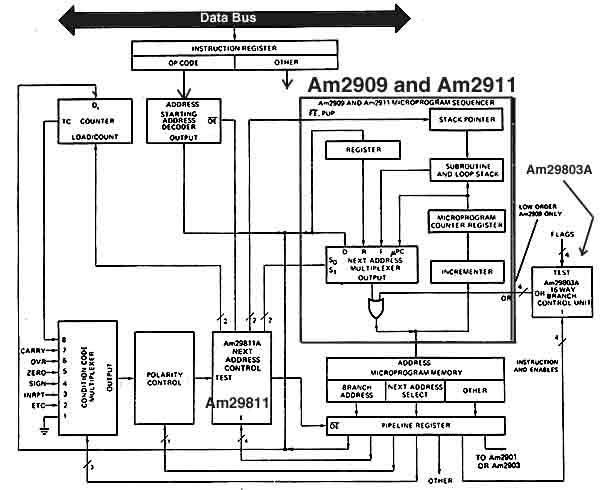Bit-Slice Design: Controllers and ALUs
by Donnamaie E. White
Copyright © 1996, 2001, 2002 Donnamaie E. White
- Pre-Introduction
- Selection of the Implementation
- Microprogramming
- Advantages of LSI
- The 2900 Family
- Language Interrelationships
- Controller Design
- Constructing the CCU
- Sequential Execution
- Multiple Sequences
- Start Addresses
- Mapping PROM
- Unconditional Branch
- Conditional Branch
- Timing Considerations
- Pipelining
- Improved Architecture
3. Adding Programming
Support to the Controller
- Expanded Testing
- Subroutines
- Nested Subroutines
- Stack Size
- Loops
- Am29811
- Am2909/11
- CASE Statement (Am29803A)
- Microprogram Memory
- Status Polling
- Interrupt Servicing
- Implementation - Interrupt Request Signals
- Vector Mapping PROM
- Next Address Control
- Am2910
- Am2910 Instructions
- Control Lines
- Interrupt Handling
- Am2914
- Interconnection of the Am2914
6. The ALU and Basic Arithmetic
- Further Enhancements
- Instruction Fields
- Instruction Set Extensions
- Sample Operations
- Arithmetic -- General
- Multiplication with the Am2901
- Am2903 Multiply
Adding Programming Support to the ControllerLast Edit September 24, 1996; May 1, 1999; July 7, 2001 AMD's Am2909/11 (1970s-1980s)The CCU logic blocks, the register, the stack, the pointer, the µPC, the incrementer and the next-address select MUX all exist as a single device, the Am2909/11 microprogram sequencer (see Figure 3-8). Figure 3-8 CCU with Am2909, Am2911A
The Am2909 and Am2911 differ in package size. The Am2911 has one input to the D (direct) position of the next-address MUX, which is shared with the input to the register (R), while the Am2909 has separate inputs for each. The Am2909 has OR inputs which allow the outputs of the CCU to be logically ORed with outside data. Both the Am2909 and Am2911 are bit-slice devices, 4 bits wide and expandable to any width in multiples of four. The typical configuration was three Am2909/11 units and one Am29811. The devices were tied together through the Cin and Cout lines of the incrementer. Three such devices can access 212 (2**12) words or a 4K ROM memory. A reasonably sized CCU might have a PROM memory between 4K and 16K. Controllers have smaller memories, usually less than 4K, depending on the particular application. At least one computer was constructed using bit-slice with a PROM of less than 2K. CASE Statement (AMD's Am29803 (1970s-1980s))There is one other desirable programming structure, the CASE statement or n-way branch. With conditional testing via the IF-THEN-ELSE structures, one test is performed at a time and branching is to one of two directions depending on the result of the test. An n-way branch performs one test and then branches to one of n locations based on the test. The Am29803 is a testing matrix which connects to the OR inputs of the Am2909. Up to four test inputs may be connected to the Am29803 inputs. A 4-bit encoded instruction selects none, one, two, three or all four test inputs to produce up to a 16-way branch in one testing step. As a sample application, consider the situation where two Am2911 units supply the 8 high-order address bits and one Am2909 supplies the last four bits. When a test is to be performed, the branch address of the start of the branch table is output by the sequencers. With the configuration indicated, the branch address table must be located within the microprogram memory such that its first address ends in four zeros (binary). The test produces four bits which are internally ORed to the Am2909 outputs and which select the specific address within the branch table. The branch table is then no more than a set of jump (JMP; GOTO) instructions. Suppose that you are to test four conditions and decide what to do next, based on the results of the four tests. The software would contain 15 jump instructions for testing, and it would be necessary to execute four instructions to complete the decision. With the Am29803, the four tests are input and an encoded result produced. A 15-deep jump instruction branch table is sufficient, and only two jump instructions need to be executed:
To use the Am29803, a four-bit instruction field must be added to the microword. A branch instruction is executed with the pipeline field supplying the Am29803 instruction to be executed in parallel with the Am2909 instruction. Since the branch address is the one produced by ORing the Am29803 outputs to the Am2909, the Am29803 is disabled by sending the appropriate instruction and execution continues. A typical CCU structure with some Am2909/11 units, an Am29811A and an Am29803 is shown in Figure 3-9. Figure 3-9 Typical CCU using the Am2909, Am2911, Am29803A, and Am29811A. Note that the least significant microprogram sequencer is an Am2909 and the more significant sequencers (referring to numeric significance) are Am2911 units.
|

